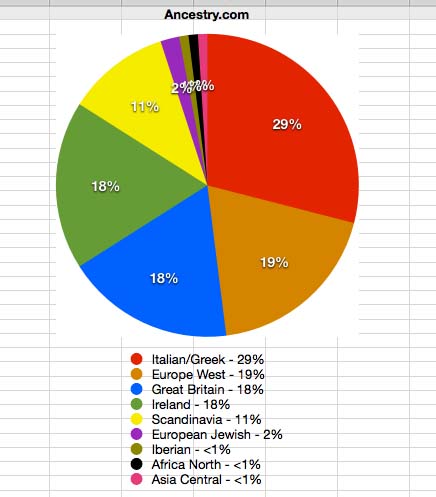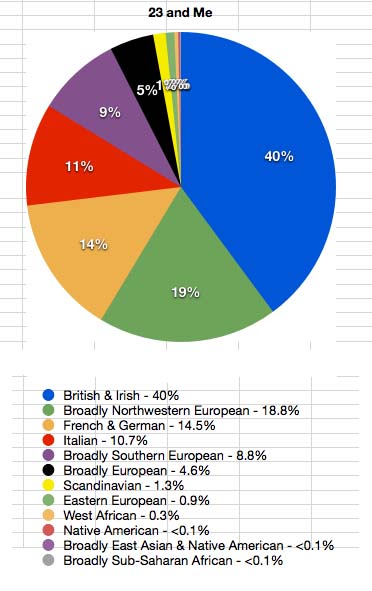The results are in! And they’re kind of muddy. Hell, they don’t quite agree which makes me wonder what each company’s criteria are for an ethnic group, especially when they lump at least two very distinctive peoples into something as amorphous as “Europe West” for the French and Germans or “Broadly Northwestern European” for…hell, I’m not exactly sure, Iceland?
Both tests entail giving them a tablespoon of saliva which you mix up with an activating agent or preservative. You mail them in and wait around a month. When you receive the e-mail from either, you check out their portal to see the outcome. I have broken them down with a spreadsheet.
First up is the cheaper and famous Ancenstry.com. I think they advertise more on television. I know they constantly bombard my Facebook news feed.
All they do is figure out where you originate based upon the genetic markers in the DNA strands which they compare to thousands of other people. One nice side feature they have is letting you build a family tree; they can often line up birth and death records if you know your ancestor’s full name. Below is what Ancestry.com came up with and it contained a couple surprises.

I was thrilled to get such a high number on Italian but how do they have much in common with the Greeks? The German element was confusingly low too given my maternal grandfather being predominantly that. Now Scandinavia makes sense since they invaded the British and Irish isles. Being slightly Jewish (aka Ashkenazi) was plausible through my German heritage; people never consider how fluid marriages were in the past. American Indian was completely missing despite all the claims I had heard growing up. Either it was bullshit or the ancestor was adopted into the tribe/nation.
Overall, I’m mostly satisfied with Ancestry.com’s work. I wish they’d break up their ethnicities better for French, German, Italian and Greek. Get it as granular as the Brits and Irish are.
Next is the more expensive and complicated 23 and Me results. They do the same ancestral estimation while also checking for a slug of genetically traceable diseases, hereditary traits and how much Neanderthal DNA is likely there.

The ethnic part feels equally arbitrary. If you move their definitions around to line up with Ancestry.com, they could be close within a few points. They too lump the French and Germans together; I’m sure if you talked to contemporary residents of those countries, they’d viciously disagree. These guys have me being predominantly from the UK which is hard to swallow when I know that half of me came from Germany during the 1870s kulturkampf and Italy around the turn of the 20th century. Not saying these ancestors were “pure” yet I think they could push the percentages further up. They agreed on dispelling the American Indian claims but couldn’t find the Jewish pieces.
Other elements were joyous. I didn’t have any of the genetically passed-on diseases they screened for although many were obscure. I only recognized PKD because I worked with someone who had it. On the Neanderthal front, I scored a mere 266 out of 2800+ attributes. Let’s hear for homo sapien superiority! Traits? Keeping my hair has a good shot while they were wrong about my eyebrow and eye color.
Sadly, I feel somewhat more confused. I doubt I could get my brother to do this and have him share the results. The reason why I would want to is a friend of mine had weirdly different outcomes with her two children. The son had very specific breakdowns of origin while the daughter was given those general regions. They have the same parents so wouldn’t they have similar ethnicities due to these things not being recessive nor dominant like MS or diabetes? Maybe I should pay for one test and twist my brother’s arm really hard to see. I don’t know any geneticists and what I find on the Internet will always be suspect.
I think I’ll lean on Ancestry.com as being closer, not because I like it better, they just have the largest sample size to compare against, 1.4 million and growing.
